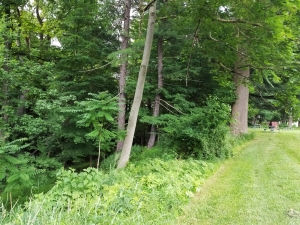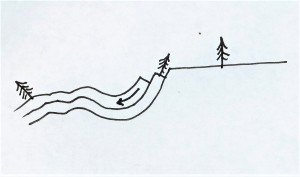A leaning tree?
The Catskill Geologists by professors Robert and Johanna Titus
The Mountain Eagle ; July 19, 2019
Take a look at our photo. Do you see anything of note? Well, if you don’t then you don’t have the trained eye of a geologist. We think you can be forgiven for that, but let’s work on it. After all, that’s what our column is supposed to be all about.

This photo was taken down at the Roosevelt Estate in Hyde Park. We go there for events all the time, so we have learned a lot about the area’s geology. The estate is spread out across the top of an ice age delta and the photo shows the edge of that delta. You probably would never guess it, but the whole bottom of the Hudson Valley was once a great, deep glacial Lake called Lake Albany. All of Hyde Park lies on a delta of that lake. The top of any delta is a very flat surface called a topset. The edge of the delta is a steep slope called the foreset. Our photo focuses on the boundary of the two. The topset is spread out to the right and all of the library buildings lie upon it. The foreset drops off quickly to the left.
A typical delta is composed of cohesive silty sediments and, with its steep slope, the foreset can be a very unstable landscape feature. Delta foresets commonly display what are called rotational slumps. Large mases of the cohesive silt break loose along curved faults and rotate downhill. You might think of this sort of thing as a slow landslide. Take a look at our second illustration. It shows a mass of earth sliding in a clockwise motion down a curved fault line. At the top of the slide trees lean backward; at the bottom, they sometimes lean forward. Now, look at our photo again. Do you see something that you didn’t minutes ago?

So, why are we writing about a feature on the east side of the Hudson River? This column is supposed to be about the central Catskills; isn’t it. Well, again. We want you to have a trained eye, alert to all sorts of geological features that you might be passing on a routine day. Have you ever noticed a leaning tree? Even if you did, did you know what it might portend? Could you possibly have suspected a landslide hazard?
And, in this case, there is something very important: is there a danger that the Roosevelt mansion, Springwood, might break loose and slide downhill? Our photo was taken just a short distance north of Springwood. We were certainly concerned when we first visited so we explored the area. But the news was good; we found no leaning trees close to Springwood and only a relatively few in the vicinity. But there was more: we found few, if any, leaning trees at the bottom of the foreset slopes. It has been our experience that with dangerous slopes, the trees at their bottoms come to be shoved forward. Take another look at our second illustration.
So, in the end, we are not overly concerned about the safety of Springwood and the whole of the Roosevelt Library and Museum. But you can never be entirely certain about these things. You might take a look at the trees where you live.
Contact the authors at randjtitus@prodigy,net. Join their facebook page “The Catskill Geologist.” Read their blogs at “thecatskillgeologist.com.”





